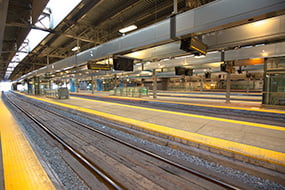In June, the Ontario government announced the infrastructure developments it had in the pipeline: 37 public-private partnership (P3) projects comprising 17 civil (such as transit, subways, highways), 16 health care, three community safety and one children’s treatment centre. Twenty-four of the projects are currently in procurement.
“The message today is clear, our government is moving from shovel-ready to shovels in the ground,” said Ontario Minister of Infrastructure Laurie Scott in a news release announcing the projects. This “signals to the infrastructure sector that Ontario remains committed to major infrastructure projects including subways, highways, health care and community safety projects. This is stimulus that will create jobs and contribute to the economic recovery of our province.”
The emphasis on economic recovery is timely given the impact of the COVID-19 pandemic on the economy — and lawyers are seeing governments invest in infrastructure in part to provide stimulus, even while some projects may be halted or delayed.
“One of the things we’re seeing now, as in past crises, is the government ramping up to improve the economy; so, a move to shovel-ready projects,” says Dana Porter, a partner at Stikeman Elliott LLP in Toronto with a real estate and infrastructure practice.
Features of infrastructure projects include a lot of planning, to make sure the project is tailored to the need, the right project at the right size and in the right place, he adds. For highway, railway and other transportation projects that involve expropriating property, “that involves a huge lead time,” Porter says. “By the time you see a shovel on the ground and work on the site, 85 or 90 per cent of the work has been done in terms of planning and getting approvals.”
Even pre-COVID, a tension existed between approving projects that were shovel-ready or still required planning, he says. Ontario’s new Bill 171, passed in July as the Building Transit Faster Act, 2020, is intended to expedite the process of inspecting and expropriating land in order to push through four public transit projects in Toronto, but, he says, “planning takes time; it’s a multi-disciplinary process.”
Governments’ biggest priority is to ensure economic activity continues and is a source of growth, says Jason Roth, head of the Capital Projects Industry Team at Bennett Jones LLP, based in Calgary.
However, he says, “I’d love to see them go in interesting new directions. I think the risk of always thinking only of shovel-ready projects is missing out [on] all the value chain of a project. There’s a huge amount of professional services, legal engineering, planning, regulatory, that’s really a key part of a project.
“It’s not just construction contractors getting paid to build things,” says Roth. “There’s a whole bunch of other work that’s related to those and keeps people busy.”
Roth adds that he would like to see many of the large projects, which take between $100 million and $200 million worth of engineering, get up and running. Then, when a pandemic arises, the projects are at a stage at which “they can go really fast,” he says.
Governments have traditionally invested in roads and bridges that have a much shorter start-up time to develop, whereas petrochemical plants can take one to two years of engineering before construction begins, Roth says.
On July 9, Alberta announced the Alberta Petrochemicals Incentive Program, a 10-year program to attract and support petrochemical projects, which Roth says is consistent with what Alberta governments have been doing.
In the context of COVID-19, “I think there’s an appreciation of the real economic bang for your buck that you can get on these types of projects. And, so, there’s probably more likelihood that some governments that may have been reluctant to do deficit spending to [finance them] are now going to do it.
“Politically, it doesn’t hurt to be announcing things in this economic climate, with concern over the impact of COVID on the economy,” he says, pointing to the federal government’s active and continuing investment in social infrastructure; in particular, wastewater treatment plants and water quality.
It’s infrastructure that had been high priority for governments and is now even more important, says Glenn Ackerley, chairman of the Construction Practice Group at WeirFoulds LLP in Toronto. Although transit has been particularly noteworthy as an investment, an interesting development in Ontario — which may signal where governments will be investing more — is in the Ontario government’s cancellation of the Halton Region Consolidated Courthouse project, a $300-million P3 project, in May.
Ackerley says the rationale for cancelling the new courthouse building may have been a desire to invest the money in technology and in other ways of making existing infrastructure more efficient.
“We’re all getting used to working from home; you can argue cases over Zoom,” he says. “So, maybe what you need to do is to give judges space to conduct virtual hearings.” This means attention can be focused on upgrading the technological infrastructure that’s needed to conduct hearings and court processes more efficiently, “as COVID has demanded, but which I think a lot of people are finding is working really well. You just log in at 2:15 — your hearing time — and all that wasted time sitting in a courtroom, waiting for your turn to come up, disappears.”
Accordingly, investing in IT infrastructure — including fibre optics, broadband and 5G technology — is expected to also become a government priority and allow people to connect more readily.
“When it comes into full play, that will be really earth-shattering,” Ackerley says. “It will be a spreading out of where people work from, and not necessarily all connected in one office building. . . . Infrastructure associated with telecommunications will definitely become a priority, because there are parts of the country that remain poorly connected.”
In Newfoundland and Labrador, Daniel Simmons has seen the $200-million expansion of the St. John’s International Airport put on hold because of COVID-19 and the drop in air travel.
“That’s on ice for now,” says Simmons, a partner at McInnes Cooper in St. John’s.
The completion of a new core science building at Memorial University will also be delayed by a year or so owing to construction problems, including the need for personal protective equipment to be worn, social distancing and for specialized people to be brought in from outside the Atlantic region who must self-isolate for two weeks.
The province’s Muskrat Falls power project has been beset by similar problems, says Simmons, which will delay the first power from that project, scheduled for this summer.
Where Simmons is seeing provincial government infrastructure spending is in health care — and on a very old jail. These infrastructure projects use P3 models, financed by the project developers and meaning the government doesn’t have to pay costs up front. Two long-term care homes, in Grand Falls-Windsor and in Gander, are being constructed, as is a new hospital in Corner Brook.
“Having embarked on that model, they’ll be able to continue despite the difficult fiscal situation,” says Simmons.
Two more P3 projects are in the development phase, and all indications are that the government will proceed with them, he adds. One is the Waterford Hospital’s Adult Mental Health and Addictions Facility in
St. John’s, which will be rebuilt as an extension to the Health Sciences Centre. And the provincial jail is even older than the old Waterford Hospital; its replacement will be a $200-million project.
For Ackerley, the question is how investing in traditional infrastructure — which most agree helps get people back to work and provides other financial stimulus — will play out in a pandemic environment.
With the number of people who will now be working from home, he asks, “What’s the impact on road construction and tolls to fund that infrastructure? Where is the money going to come from to pay for that infrastructure when the government will be handing a lot of it back to us [in the form of emergency relief programs]?
“Governments borrow to spend; some of that is offset by tax revenues, but not all, and the deficit keeps growing. If you’ve been borrowing money to replace lost income, where do the dollars come from to pay for infrastructure?”
This means the model of P3s used in past years may become more commonly used for government infrastructure projects, he says. The government gets the asset built, but it pays for it over a long period of time.
“As much as infrastructure is the big-ticket thing that governments love to announce, I struggle to think where the money will come from, unless through the P3 model.”
Although many of the government’s priorities may remain the same, he adds, some may be rethought, such as office buildings. Since many people are and will continue to be working from home, less office space and roads may be needed.





